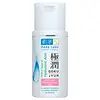What's inside
What's inside
 Key Ingredients
Key Ingredients

 Benefits
Benefits

No benefits
 Concerns
Concerns

 Ingredients Side-by-side
Ingredients Side-by-side

Centella Asiatica Leaf Extract
Skin ConditioningButylene Glycol
HumectantGlycerin
HumectantDimethicone
EmollientCaprylic/Capric Triglyceride
MaskingGlycereth-26
HumectantNiacinamide
SmoothingCetearyl Glucoside
Emulsifying1,2-Hexanediol
Skin ConditioningHydroxyacetophenone
AntioxidantCetearyl Alcohol
EmollientCyclopentasiloxane
EmollientSorbitan Olivate
EmulsifyingCarbomer
Emulsion StabilisingPEG-100 Stearate
Glyceryl Stearates
EmollientMethylpropanediol
SolventTriethanolamine
BufferingAllantoin
Skin ConditioningPropylene Glycol
HumectantSodium Hyaluronate
HumectantDisodium EDTA
Tocopherol
AntioxidantStephania Tetrandra Root Extract
Skin ConditioningHydrogenated Lecithin
EmulsifyingEctoin
Skin ConditioningHexylene Glycol
EmulsifyingStearic Acid
CleansingCholesterol
EmollientCeramide NP
Skin ConditioningUndaria Pinnatifida Extract
Skin ConditioningNelumbo Nucifera Seed Extract
AntimicrobialHydrolyzed Hyaluronic Acid
HumectantHydroxypropyltrimonium Hyaluronate
Sodium Acetylated Hyaluronate
HumectantHyaluronic Acid
HumectantHydrolyzed Sodium Hyaluronate
Skin ConditioningPotassium Hyaluronate
Skin ConditioningSodium Hyaluronate Crosspolymer
HumectantCeramide EOP
Skin ConditioningCeramide AP
Skin ConditioningMadecassoside
AntioxidantChlorella Vulgaris Extract
Skin ConditioningTorreya Nucifera Seed Oil
EmollientPanthenol
Skin ConditioningDimethylsilanol Hyaluronate
HumectantCentella Asiatica Extract
CleansingCentella Asiatica Leaf Extract, Butylene Glycol, Glycerin, Dimethicone, Caprylic/Capric Triglyceride, Glycereth-26, Niacinamide, Cetearyl Glucoside, 1,2-Hexanediol, Hydroxyacetophenone, Cetearyl Alcohol, Cyclopentasiloxane, Sorbitan Olivate, Carbomer, PEG-100 Stearate, Glyceryl Stearates, Methylpropanediol, Triethanolamine, Allantoin, Propylene Glycol, Sodium Hyaluronate, Disodium EDTA, Tocopherol, Stephania Tetrandra Root Extract, Hydrogenated Lecithin, Ectoin, Hexylene Glycol, Stearic Acid, Cholesterol, Ceramide NP, Undaria Pinnatifida Extract, Nelumbo Nucifera Seed Extract, Hydrolyzed Hyaluronic Acid, Hydroxypropyltrimonium Hyaluronate, Sodium Acetylated Hyaluronate, Hyaluronic Acid, Hydrolyzed Sodium Hyaluronate, Potassium Hyaluronate, Sodium Hyaluronate Crosspolymer, Ceramide EOP, Ceramide AP, Madecassoside, Chlorella Vulgaris Extract, Torreya Nucifera Seed Oil, Panthenol, Dimethylsilanol Hyaluronate, Centella Asiatica Extract
Water
Skin ConditioningHydrogenated Polydecene
EmollientCaprylic Acid
CleansingPEG-10
HumectantPPG-20 Methyl Glucose Ether
Skin ConditioningPEG-6 Sorbitan Stearate
EmulsifyingGlyceryl Stearate
EmollientDimethicone
EmollientStearic Acid
CleansingCarbomer
Emulsion StabilisingMethylparaben
PreservativeBehenyl Alcohol
EmollientPropylparaben
PreservativeTea-Lauroyl Glutamate
CleansingDisodium EDTA
Sodium Acetylated Hyaluronate
HumectantIngredients Explained
These ingredients are found in both products.
Ingredients higher up in an ingredient list are typically present in a larger amount.
Carbomer is a polymer of acrylic acid. Its main role is to create a gel consistency.
A high amount of carbomer can cause pilling or balling up of products. Don't worry, most products contain 1% or less of carbomer.
Dimethicone is a type of synthetic silicone created from natural materials such as quartz.
What it does:
Dimethicone comes in different viscosities:
Depending on the viscosity, dimethicone has different properties.
Ingredients lists don't always show which type is used, so we recommend reaching out to the brand if you have questions about the viscosity.
This ingredient is unlikely to cause irritation because it does not get absorbed into skin. However, people with silicone allergies should be careful about using this ingredient.
Note: Dimethicone may contribute to pilling. This is because it is not oil or water soluble, so pilling may occur when layered with products. When mixed with heavy oils in a formula, the outcome is also quite greasy.
Learn more about DimethiconeDisodium EDTA plays a role in making products more stable by aiding other preservatives.
It is a chelating agent, meaning it neutralizes metal ions that may be found in a product.
Disodium EDTA is a salt of edetic acid and is found to be safe in cosmetic ingredients.
Learn more about Disodium EDTASodium Acetylated Hyaluronate is a type of Hyaluronic Acid.
Hyaluronic Acids help moisturize, soothe, and protect the skin.
Read about common types of Hyaluronic Acid here:
Sodium Hyaluronate
Hydrolyzed Hyaluronic Acid
Hyaluronic Acid
Stearic Acid is a fatty acid. It is an emollient, emulsifier, and texture enhancer.
As an emollient, stearic acid helps soften skin. It aids the skin's protective barrier by preventing water loss. It also provides a gentle cleansing effect without stripping away natural oils.
Stearic acid may also be used to enhance the texture of products. It can add volume and stabilize ingredients such as water and oil. This can help water and oil ingredients from separating.
Sources of stearic acid include animal or vegetable fats/oils such as coconut or shea. It can be naturally found in butter, cocoa butter, shea butter, vegetable fats, and animal tallow.
This ingredient may not be Malassezia folliculitis, or fungal-acne safe.
Learn more about Stearic Acid